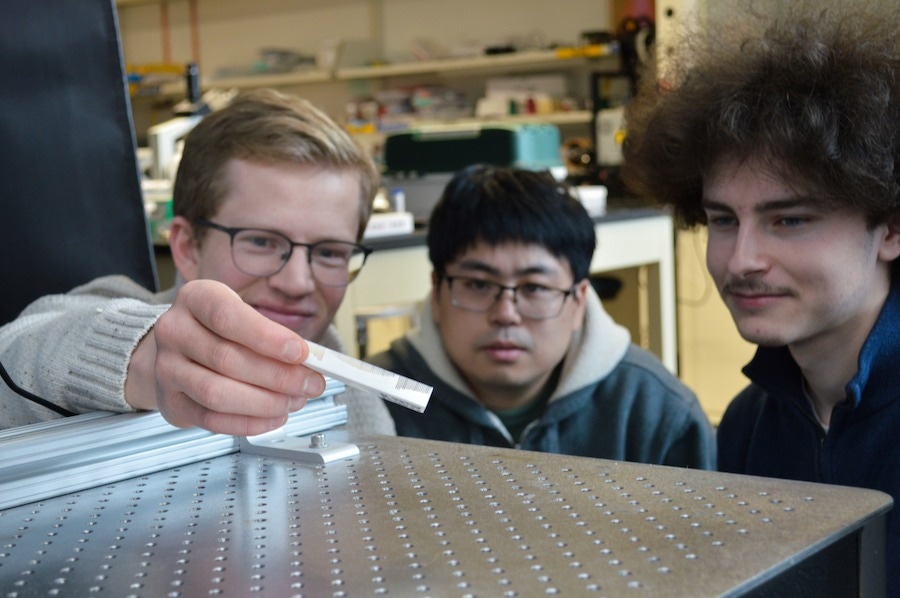Scientists at the University of Minnesota Twin Cities have identified a novel way to move items using ultrasound waves. The study paves the way for contactless manipulation in fields such as manufacturing and robotics, where devices will not require a built-in power source to move.

University of Minnesota Twin Cities researchers have discovered a new method to move objects using ultrasound waves, opening the door for using contactless manipulation in industries such as robotics and manufacturing. In the above image, University of Minnesota students Matthew Stein, Yujie Luo, and Sam Keller interact with an object that has a metamaterial surface. Image Credit: Olivia Hultgren.
The work was published in Nature Communications, a peer-reviewed, open-access scientific journal.
While light and sound waves have previously been shown to manipulate objects, these objects were always smaller than the wavelength of sound or light, or on the order of millimeters to nanometers, respectively. Employing metamaterial physics concepts, the University of Minnesota group has developed a mechanism for moving larger objects.
Metamaterials are materials that have been engineered to interact with waves such as light and sound. The scientists were able to drive an object in a specific direction without physically touching it by placing a metamaterial pattern on its surface.
We have known for a while that waves and light and sound can manipulate objects. What sets our research apart is that we can manipulate and trap much bigger objects if we make their surface a metamaterial surface, or a ‘metasurface. When we place these tiny patterns on the surface of the objects, we can basically reflect the sound in any direction we want. And in doing that, we can control the acoustic force that is exerted on an object.
Ognjen Ilic, Study Senior Author and Benjamin Mayhugh Assistant Professor, Department of Mechanical Engineering, University of Minnesota
Similar to the tractor-beam technology in science fiction works like Star Trek, the researchers have developed a method that allows them to draw an object toward a source as well as drive it ahead.
In industries like manufacturing or robotics, their technique might be helpful for moving items.
Contactless manipulation is a hot area of research in optics and electromagnetism, but this research proposes another method for contactless actuation that offers advantages that other methods may not have. Also, outside of the applications that this research enables, expanding upon our knowledge of physics is just a very exciting thing to do in general!
Matthew Stein, Study First Author and Graduate Student, Department of Mechanical Engineering, University of Minnesota
The researchers plan to test out higher frequencies of waves, various materials, and larger object sizes in the future, even though this study is more of a proof of concept.
In a lot of fields of science and engineering, robotics especially, there is the need to move things, to transfer a signal into some sort of controlled motion. Often this is done through physical tethers or having to carry some source of energy to be able to perform a task. I think we’re charting in a new direction here and showing that without physical contact, we can move objects, and that motion can be controlled simply by programming what is on the surface of that object. This gives us a new mechanism to contactlessly actuate things.
Ognjen Ilic, Study Senior Author and Benjamin Mayhugh Assistant Professor, Department of Mechanical Engineering, University of Minnesota
The study was funded by the Minnesota Robotics Institute and the Air Force Office of Scientific Research.
Researchers move object hands-free using ultrasound waves and metamaterial physics
This video shows an object with a metamaterial pattern on its surface (left) being contactlessly controlled by acoustic waves (right). Video credit: Laboratory for Nano Optics and Mechanics, University of Minnesota.
Journal Reference
Stein, M., et al. (2022) Shaping contactless radiation forces through anomalous acoustic scattering. Nature Communications. doi.org/10.1038/s41467-022-34207-7.